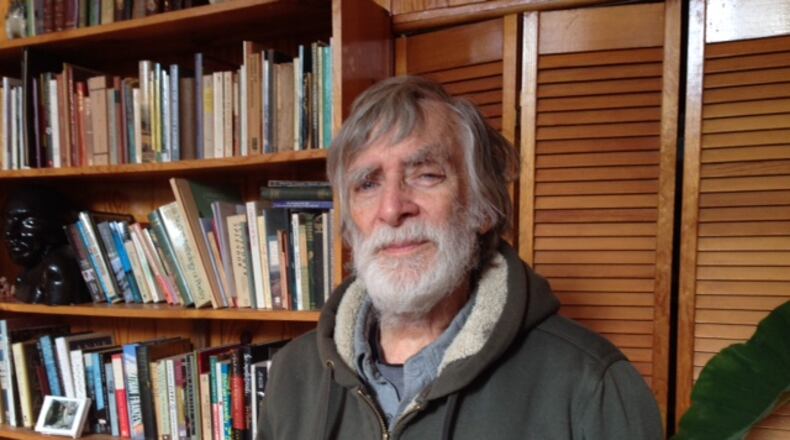Psalm XIX
The Almanack Horoscope (Time Watching)
Moon Time: The Corn Harvest Moon, full on October 5, wanes until it reaches perigee (its position closest to Clark County) on October 9 and enters its final quarter on October 12 at 7:25 a.m.. Rising in the evening and setting in the morning, this moon passes overhead in the middle of the night.
Sun Time: At the start of October, the day's length is about eleven hours and forty-five minutes. At the end of the month, the day is only ten hours and a half hours long.
Planet Time: Venus and Mars, so close they seem to touch, are the morning stars this month, Jupiter will shine in the west for another couple of weeks.
Star Time: The Pleiades, and the Hyades of Taurus lie on the eastern horizon well after dark, announcing middle autumn in the Northern Hemisphere. Nonetheless, summer's Milky Way is still almost directly overhead, and June's Corona Borealis has still not set by ten o'clock. Orion has not yet vanquished Hercules. Cygnus, the swan is still high above Springfield in the west, along with August's Aquila and Lyra.
Shooting Star Time: The Draconid meteors fall (at the rate of about ten per hour) in the vicinity of the North Star after midnight on the 7th, but the gibbous moon will make viewing difficult.
The October 13 Front: The coldest morning so far in the season often occurs as this front arrives, and chances of a low in the teens or 20s reach 20 percent for the first time since spring. This front often is the first front to bring a serious chance of snow flurries to Clark County. Highs below 50 degrees now occur about 30 percent of the time.
Zeitgebers: Events in Nature that Tell the Time of Year: Goldenrod is seeding now, pods of the eastern burning bush are open, hawthorn berries redden, wild grapes are purple. Streaks of scarlet appear on the oaks, shades of pink on the dogwoods. The surviving ashes show red or gold; the catalpas and the cottonwoods blanch. Shagbark hickories, tulip trees, sassafras, elms, locusts and sweet gums change to full yellow, merge with the swelling orange of the maples.
As the canopy thins above the garden, the tall sedums begin to relinquish their petals, and autumn crocuses die back. August’s jumpseeds are jumping, touch-me-nots popping, thimble plants unraveling. The toothed leaves of beggarticks darken overnight.
Farm and Garden Time: Harvest honey from your hives (leaving plenty for the bees). Also bring in pumpkins and winter squash before the weather gets much colder.
The darkening moon after the 5th favors planting root crops, setting spring flower bulbs and transplanting perennials.
The fields may be regreening now with secondary growth and fall varieties. Provide plenty of free choice hay to livestock in order reduce the chance they will gorge themselves on fresh growth.
Marketing Time: Most pumpkins are sold between September and January. Local markets are important until after Halloween, when commercial buyers replace them. If you have a little land, you may be able to sell about $2,000 worth of pumpkins per acre.
Mind and Body Time: Autumn is often a period during which people tend to reminisce and replay particular periods of ther lives. Such memories often produce nostalgia and sometimes sadness. One of the best cures: helping others.
Creature Time (for fishing, hunting, feeding, bird watching): This time of October is migration time for most warblers, grosbeaks and field sparrows. Hawks move south, resting on fences and high wires to look for prey.
The moon will be overhead in the night this week, making mornings the best lunar time for hunting and fishing (when the moon is at its second-most-stimulating position). The falling barometer in advance of the October 7 and October 13 cold fronts should encourage fish and game activity. Once the fronts pass through, activity often declines.
Journal
I left for New York in the fog, and then an hour later, the clouds turned dark, and the wind came in strong from the northeast. Traffic was loud and heavy until I left Ohio.
When I stopped at a deserted roadside parking area out of the wind and away from the highway and the rush of trucks and cars, I felt a relief in the quiet, surrounded by soft grasses speckled with thin-leafed buttercups, daisies with floppy petals, purple heal-all, white clovers, red clovers a few hawkweeds and dandelions.
This was such a plain and ordinary habitat, its sparse vegetation a simple and finite retreat, unplanted and haphazard, that, for some reason, separated me from the complexities and risks of the long trip, and from some vague sadness that I must have caught from leaving home, and from all the clouds and chill, and from the dying Johnson grass and prickly teasel of the rougher and wilder freeway borders.
Poor Will’s Almanack for 2018 will soon be available. Order yours from Amazon, or, for an autographed copy, order from www.poorwillsalmanack.com.
About the Author
